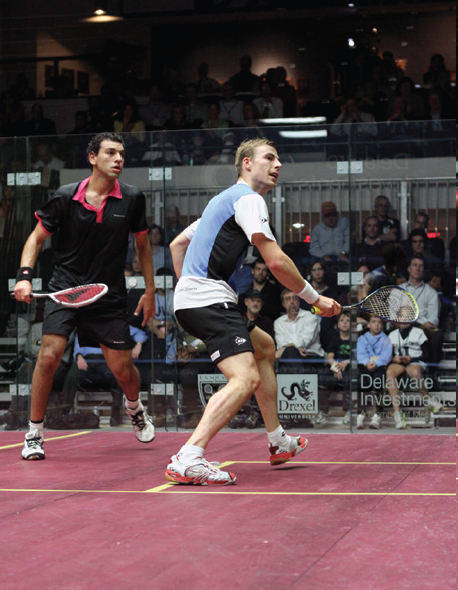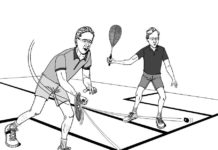
By Barry Faguy, WSF Referees and Rules Committee
Here’s another well-known action in the sport that we have often referred to only incidentally in other articles. However, if you a half-decent job when it’s your turn to referee, then you’ll need a few more details about what it is—and what it is not.
A bit of history
The subject of turning has garnered much discussion over the years—for the most part because it is considered a dangerous action. There have been multiple suggestions about what to do about it—including the outright banning of turning, an idea that would result in a number of problems by itself. It’s always been felt that no reasonable form of return should be forbidden. So, another suggestion that has come up was to allow the act of turning (to demonstrate the ability to make the return)—but forbid the actual striking of the ball. In any case, the debate continues in the hallowed circles. Up until the 2001 rules, incidences surrounding turning virtually always ended with a let decision, but with the 2001 rules (the latest), a stroke was mandated against the striker in the event that the non-striker was hit by the ball after turning by the striker.
The definition
Turning is deemed to have occurred when the striker strikes (or refrains from striking) the ball on the right of the body after the ball has passed to the left—or vice versa. The striker can either follow it around by physically turning, or simply by allowing the ball to pass around the body. The significance of this definition is that, if indeed there was ‘turning’ and there is then a stoppage in play for whatever reason, the rules have specific provisions to cover the various resulting situations.
A typical mistake is to label as turning, the act of ‘shaping’—the action a player does when rapidly bringing the racket across the body from right to left (or vice versa) to hit a ball that came towards them by surprise. This typically occurs when a ball, hit hard along a side wall, juts out towards the middle with the familiar ‘crack’ noise after hitting the vertical nick (junction between the front wall & side wall). It’s not turning because the ball at all times stays in front of the striker. If it occurs and there’s a request for a let, you simply apply the usual provisions for swing interference.
The usual scenario
For example, for a right-hander, it would typically happen on the left of the court when a wide shot hits the side-wall, then goes to the back wall. The striker then turns the body counterclockwise to follow the ball around and into the center of the court (see photos above)—and is now ready to play the ball on what is now the forehand side. As mentioned above, the striker doesn’t actually have to follow the ball around. Often referred to as ‘mental turning’, and usually done by experienced players, the striker simply allows the ball to go around the body without following it physically—thus the ‘mental’ moniker. It still passes by on one side of the body, and is hit on the other—so the decisions outlined below are still the same.
THE DECISIONS
If the striker turns and hits the ball which hits the non-striker:
- It’s STROKE TO NON-STRIKER if the non-striker was hit by the ball traveling either towards the front wall or a side wall.
- It’s a STROKE TO NON-STRIKER in all cases, even if the return would not have been good.
- It’s STROKE TO STRIKER if the non-striker was hit by the ball—but this time because of the non-striker’s deliberate movement to intercept it. You can be sure that natural instincts of self-preservation have made that occurrence a rarity!
If the striker turns, refrains from hitting the ball, and appeals for a let:
- It’s a LET if there was a reasonable fear of the ball striking the non-striker providing the striker could have made a good return.
- It’s a NO LET if the non-striker was well clear and there was NO reasonable fear of striking that non-striker.
- It’s a NO LET if the striker could NOT have made a good return.”
WHAT ABOUT THE WALLS?
Although the ball usually hits the back wall and/or side wall, it isn’t a necessary condition. Occasionally, a player is quick enough to wheel around a shot that has passed by, then get behind it before it reaches the back wall. (Trust me, I’ve done it!). And yes, sometimes it doesn’t touch the side wall either. The fact that the ball does not touch a side wall or back wall has no bearing on the decisions.
MUST I STOP PLAY?
It isn’t obligatory to stop after turning. The striker has the option of striking it or not, but this should only be done if convinced that there is no danger to the non-striker. Should the player strike the ball and endanger the non-striker, the referee should penalize the striker for dangerous play with a Rule 17 assessment.
UNNECESSARY TURNING & STOPPING?
Sometimes a player will want to avoid hitting a difficult shot and will quickly move into the corner to place the ball on that player’s other side—thus setting up an artificial turning situation—and then asks for a let. If the referee judges this to be a deliberate attempt to stop play rather than a legitimate attempt to play the ball, then a NO LET is the correct decision since this is considered a form of created interference. The intent here is to keep the game continuous as much as possible. Luckily, this is also a rare occurrence.
WHAT ABOUT SWING INTERFERENCE DURING TURNING?
You probably have noticed that most rules about turning deal with ‘ball’ interference (interference that the ball can encounter on the way to the front wall). However, interference to the swing is another occasional occurrence with turning—so it was included in the 2001 rules as well. It would generally be a stroke if the swing was prevented (as we have seen in past articles) during such turning actions, but Guideline 5 acknowledges the reality of this action being “so quick”—and gives the poor non-striker a break, mandating only a let.
A PLAYING TIP
OK, OK, this is an officiating article, but we’ll digress a wee bit. When your opponent has hit the typical wide shot (often as a serve) that usually leads to a turning action, be alert for it and DON’T follow it around. Quickly back away from it towards the middle, keeping it on the same side of your body. This avoids the ‘turning’ movement, forcing your opponent to back away to stay clear—thus opening up the entire court for you to drive it back into the same corner.





